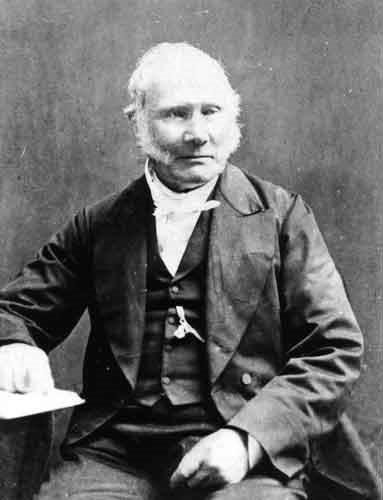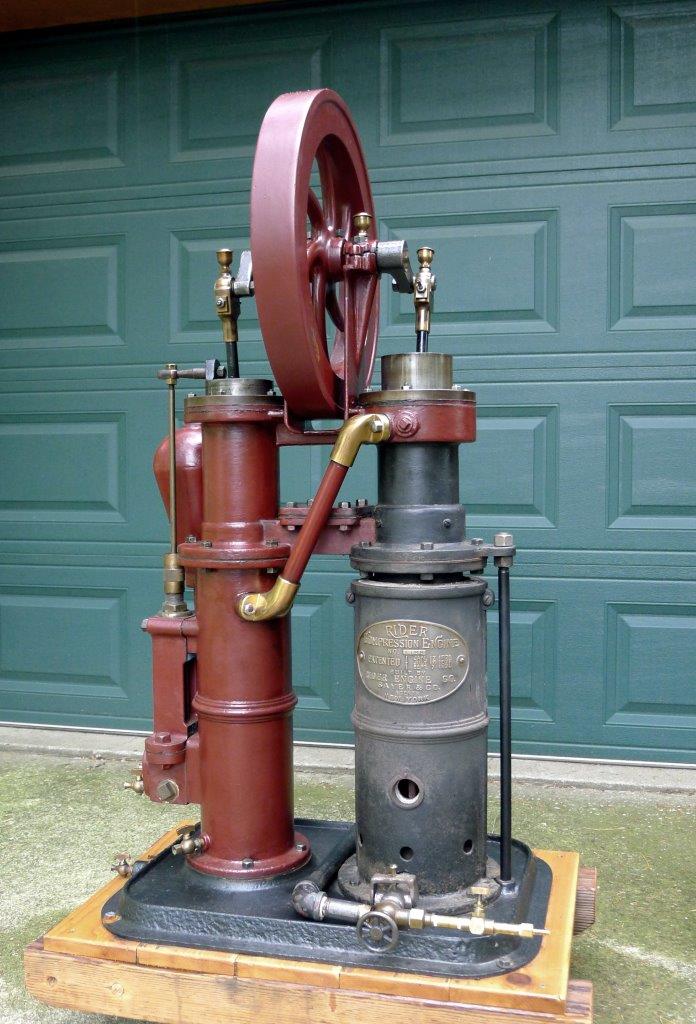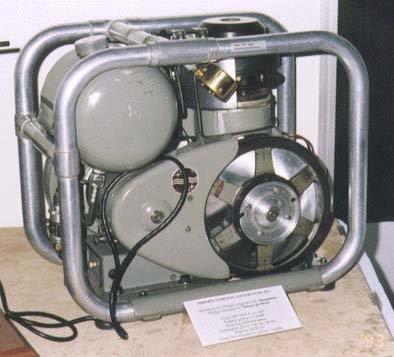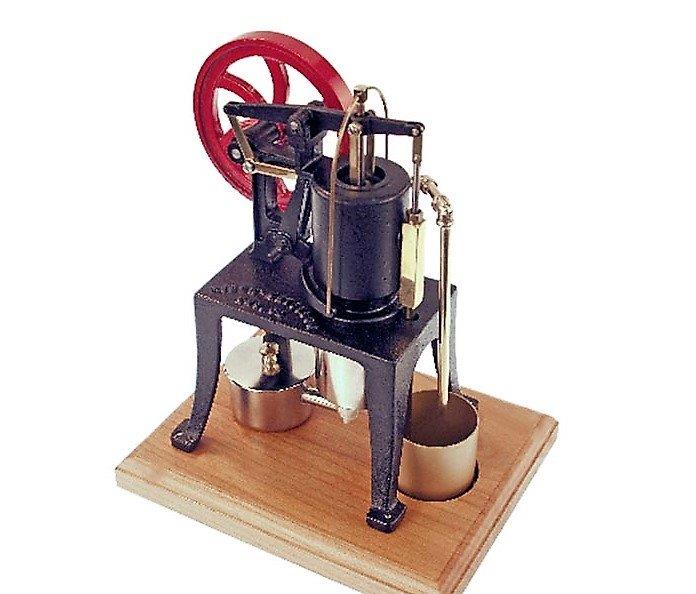
June 2017
Hot Air Engines
A Beginner's Guide
Part 2: Some Engines
By Paul Harvey
Last month's Flywheel article introduced the reader to the inventor of the world's most practical hot air engine, Rev. Dr. Robert Stirling. His portrait is seen in Photo 1. The article discussed the operation of Stirling's engine as well as some basic thermodynamic principles used in his unique design. Although there had been previous attempts to construct a hot air engine, the Stirling cycle was the first practical solution. It is still used in ones built today.
Rev. Stirling was a Scottish minister in the Perthsire area. In 1816, coal mining was the main industry there, but the steam engine, needed to pump water from the mines, was in its infancy. He witnessed many members of his congregation being horribly injured or killed in boiler explosions. Being mechanically inclined, he set out to build a safer engine - and so he did! His hot air engine was completely safe, being free of any explosion risk. The patent engine is seen in Photo 2. It soon gained popularity not only in Perthshire, but wherever safe power was needed.
Another important player in our story is John Ericsson, who was working with "flame engines" in the 1820s, not long after Stirling's 1816 patent. His first engines were not successful, using an open cycle with valves which brought new air into every revolution of the engine. Note Photo 3.
John Ericsson was born in Sweden and became a naturalized American citizen in 1848. He was extremely dedicated to his work as his portrait suggests, shown in Photo 4. Although it was not powered by a hot air engine, one of his major achievements was the design of the USS MONITOR in 1862. Departing a bit from my story, I hope the reader will enjoy this tale from the Civil War.
The day was March 9, 1862, and the Confederacy and Union were engaged in the violent naval battle of Hampton Roads. For days before, the monstrous Confederate iron clad ship, the CSS VIRGINIA, was wreaking havoc on the wooden Union fleet. The VIRGINIA was built on the wreck of the USS MERRIMACK. It was clad in massive iron plates, steam powered and heavily armed. On the morning of March 9, the VIRGINIA was greeted by an odd vessel which was protecting the Union fleet. This was Ericsson's USS MONITOR. Often described as a "cheese box on a raft", it had very low profile and featured a revolving turret armed with two huge 12-inch cannons. The two vessels battled fiercely for four hours, then withdrew in a draw. The painting depicted by Photo 5 illustrates the battle. Naval warfare was changed forever!
Skipping many pages in Ericsson's history, we finally find him partnering with Alexander Rider to form the Rider-Ericsson Engine Company. They became the largest maker of hot air engines in this country. Both versions were built and both were successful. Photo 6 shows a Rider type engine and Photo 7 shows an Ericsson. Notably, both these engines used the Stirling cycle.
For those who wish to know more about the Rider-Ericsson story, an excellent Bores & Strokes booklet is available in the museum gift shop. Entitled "The Rider-Ericsson Engine Company - A Short History," it was authored by Dr. Brent Rowell, a leading authority on the company and founders (please see our Publications page for more information).
Being dedicated to the internal combustion engine, the museum has only two hot air engines in its collection. Both are located in the Susong Building. Photo 8 shows the museum's Ericsson style engine; note the firebox below the cylinder where wood or coal can be used as fuel. Hot air engines are external combustion, burning their fuel outside of the engine cylinder. Also displayed, as seen in Photo 9, is this little Heinrici engine, made in Germany. It uses gas as the fuel and could have easily powered a sewing machine or jeweler's lathe. Both are Stirling cycle. Over the years, their uses were endless!
An interesting use of the Stirling cycle engine emerged in the early twentieth century as cooling fans. Sounding contradictory, these units used a small flame to operate the engine to turn the fan blades. Perhaps the most common was the Lake Breeze Fan, built by William J. H. Strong Company of Chicago between the years of 1915 and 1919. Photo 10 illustrates the 16-inch blade diameter, Model B, floor-mounted fan. Standing about 41 inches tall, it was heated and powered by the small kerosene lamp shown. Price for this fan was $19.50. Hundreds were shipped to Southeast Asia and used were electricity was not available. But the electric fan had emerged in the country and cut short the life of these great little units. A great idea just a bit too late.
Today, there is a multitude of Stirling cycle items available. Starting perhaps in the 1950s, Philips marketed this 200 watt generator to the camping industry. With its Stirling engine, it operated absolutely noiselessly and burned a variety of low grade fuels. It is seen in Photo 11. For those with a remote cabin that used a wood stove, this clever fan could be placed on any hot surface to circulate the air. Still available today, it is seen in Photo 12.
A quick look at the internet reveals literally hundreds of toy Stirling cycle engines. Some are imported and are priced about $20 while others are high quality American-made and priced near $1,000. A few examples are shown. Photo 13 shows an imported, low temperature Stirling engine. Needing only eight degrees temperature difference between the hot and cold side, it is guaranteed to run with the heat of one's hand. Another inexpensive import, seen in Photo 14, is this Stirling engine driving a small generator. It comes with an LED lamp that can be illuminated with the electricity it produces. On the other hand, Photo 15 shows a cast iron, American-made model of an Ericsson Engine. More expensive, yes, but it is historically accurate and it will last a lifetime.
The future of the Stirling hot air engine appears very exciting! About 201 years after its invention, time again is considering these remarkable machines. With the new smaller hybrid automobiles, the Stirling engine is being studied to be a source of power to recharge the batteries. With fuel cell technology, these engines would be quiet, efficient, and pollution free. They are already used on satellites, where they are powered by solar energy, to operate control mechanisms and other navigation devices. Another frequent use today is operating vast areas of solar panels, keeping them pointing directly toward the sun. Submarines are adopting them to perform small functions quietly and efficiently, using the heat from the nuclear reactors. The story goes on and on. I am sure Rev. Stirling would be delighted!
As I was researching this article, I recalled that I had a toy engine of some sort tucked away. Finding it easily, I was delighted to discover that it was a hot air engine. The engine was complete and easy to clean. I learned that it was manufactured by the Ernst Planck Toy Company of Nuremberg, Germany, about 1914. Hundreds of these toys, and similarly high-quality toys, were imported to delight the kids of all ages. I was cxcited to try the engine and Photo 16 shows its first run on my workbench. What a thrill!!!!
This concludes my two-part article on hot air engines. I certainly hope the reader enjoys reading it as much as I did researching it.
At this time, after six and one half years of writing the monthly Flywheel articles, 78 total, I will drop back to doing bimonthly articles. My next article will be in August and will feature our June show report.

Photo 1: Rev. Dr. Robert Stirling

Photo 2: Stirling patent engine

Photo 3: Ericsson open cycle engine

Photo 4: John Ericsson

Photo 5: USS Monitor vs. CSS Virginia

Photo 6: Rider engine

Photo 7: Ericsson engine

Photo 8: Museum's Ericsson engine

Photo 9: Museum's Heinrici engine

Photo 10: Lake Breeze fan

Photo 11: Philips generator set

Photo 12: Stirling-powered fan

Photo 13: Low temperature Stirling engine

Photo 14: Stirling engine and generator

Photo 15: Model Ericsson engine

Photo 16: Ernst Planck toy engine